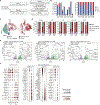Human γδ T cells in diverse tissues exhibit site-specific maturation dynamics across the life span
- PMID: 38848342
- PMCID: PMC11425769
- DOI: 10.1126/sciimmunol.adn3954
Human γδ T cells in diverse tissues exhibit site-specific maturation dynamics across the life span
Abstract
During ontogeny, γδ T cells emerge from the thymus and directly seed peripheral tissues for in situ immunity. However, their functional role in humans has largely been defined from blood. Here, we analyzed the phenotype, transcriptome, function, and repertoire of human γδ T cells in blood and mucosal and lymphoid tissues from 176 donors across the life span, revealing distinct profiles in children compared with adults. In early life, clonally diverse Vδ1 subsets predominate across blood and tissues, comprising naïve and differentiated effector and tissue repair functions, whereas cytolytic Vδ2 subsets populate blood, spleen, and lungs. With age, Vδ1 and Vδ2 subsets exhibit clonal expansions and elevated cytolytic signatures, which are disseminated across sites. In adults, Vδ2 cells predominate in blood, whereas Vδ1 cells are enriched across tissues and express residency profiles. Thus, antigenic exposures over childhood drive the functional evolution and tissue compartmentalization of γδ T cells, leading to age-dependent roles in immunity.
Figures






References
-
- Itohara S, Farr AG, Lafaille JJ, Bonneville M, Takagaki Y, Haas W, Tonegawa S, Homing of a gamma delta thymocyte subset with homogeneous T-cell receptors to mucosal epithelia. Nature 343, 754–757 (1990). - PubMed
Publication types
MeSH terms
Substances
Grants and funding
LinkOut - more resources
Full Text Sources
Molecular Biology Databases

